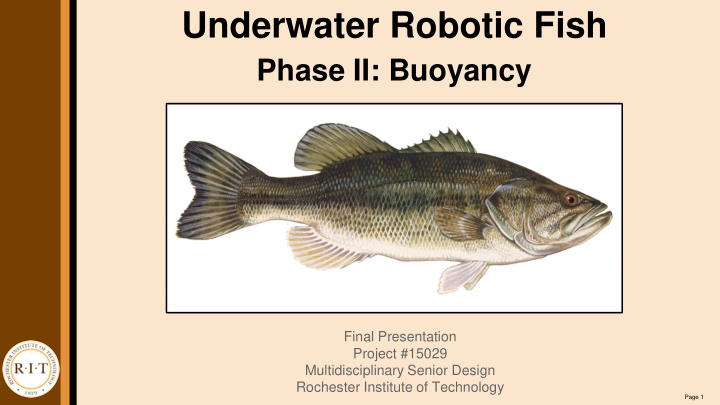



Underwater Robotic Fish Phase II: Buoyancy Final Presentation Project #15029 Multidisciplinary Senior Design Rochester Institute of Technology Page 1
Team Members and Roles Name Role Sarah Bailey Project Manager and Buoyancy Lead Chloe Bohlman Webmaster and Electrical Support Mark Pitonyak Electrical Lead Igor Drobnjak Systems Lead Brandon Michale Biomedical Lead Frederick Cookhouse Mechanical Lead Page 2
Agenda ● Problem Statement ● Buoyancy ● Communications ● Final Design ● Performance Vs. Requirements ● Final Budget - BOM Review ● Recommendations ● Documentation Page 3
Problem Statement The objective of this project is to create an underwater robot that looks and swims like a fish. The fish is to achieve these biomimetics by utilizing McKibben muscles to hydraulically propel the fish. The fish will be able to swim forward and turn, and have depth control using active buoyancy in both RC and autonomous modes. Objectives: ● Design an active buoyancy system ● Add underwater remote controlling ● Improve physical aesthetics of the fish Page 3
Buoyancy The fish was successfully able to dive to a depth of 3 ft and return to the surface utilizing manual control of the valves and ballast system. See Videos Posted on EDGE Page 3
Communication Problem: High frequency wireless systems are strongly attenuated in water. Solution: Developed a 315 MHz transceiver to communicate with the fish underwater. Results Range in air: 300 ft Range in water: 3 ft Throughput: 10,000 bps Page 3
Final Design Page 3
Performance vs. Requirements Page 3
Performance vs. Requirements Page 3
Performance Vs. Requirements Page 3
Final Budget - BOM Review Mechanical $ 232.81 Electrical $ 203.76 Main PCB $ 140.73 RF Transceiver $ 47.16 Controller PCB $ 8.81 TOTAL $ 633.26 Page 3
Recommendations ● Shell ○ Devote more time and budget to testing shell materials ○ Recommendations have Make small samples as with skin ○ If molding on foam, use solid core been recorded in a ○ If using fabric strips, dip in the resin instead of document for future teams painting it on to reference. The left is an ○ DO NOT LEAVE THIS UNTIL THE LAST FEW example of one major WEEKS BEFORE IMAGINE system that did not meet an ■ You will not finish on time. This has been engineering requirement the case the past two years. Do not and our recommendations become the third team to fail at this. ● Skin to prevent this issue in the ○ Attach velcro by sewing it to the skin future. ○ This was a big concern for us, as when we went to use the ecoflex, the velcro peeled right off, leaving us with no practical method for holding the skin on the tail Page 3
Documentation ● Technical Paper ● Instruction Manual ● EDGE Website ● BOM ● Recommendations ● ImagineRIT Poster ● Performance Vs. Requirements Page 3
Recommend
More recommend